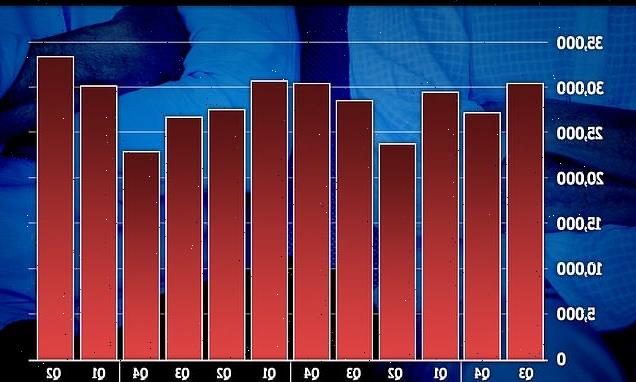
Divorce applications soar to their highest level in a decade following introduction of new ‘no-fault’ laws aimed at ending ‘blame game’ between separating spouses
- Divorce applications soar to their highest level in a decade in England and Wales
- It follows the introduction of new ‘no-fault’ laws introduced in April this year
- These were aimed at ending the ‘blame game’ between separating couples
Divorce applications have soared to their highest level in a decade following the introduction of new ‘no-fault’ laws in England and Wales this year.
New figures from the Ministry of Justice, published today, revealed that between April and June this year there were more than 33,500 divorce applications.
This was up more than 22 per cent from the same period last year and represents the highest number of applications in a decade.
More than 99 per cent of the applications between April and June this year were made under new legislation introduced on 6th April.
Billed as the biggest shake-up in divorce law for more than half a century, the legislation ended the need for a separating couple to apportion blame for the breakdown of their marriage.
Previously, one spouse was forced to make accusations about the other’s conduct, – such as ‘unreasonable behaviour’ or adultery – or face years of separation before a divorce could be granted.
This was regardless of whether a couple had mutually decided to separate.
One expert predicted the number of divorce applications would soar even higher in the coming months as the cost-of-living crises piles pressure on relationships.
New figures from the Ministry of Justice, published today, revealed that between April and June this year there were more than 33,500 divorce applications
New legislation has ended the need for a separating couple to apportion blame for the breakdown of their marriage
For all divorce cases made between April and June, 98 per cent were digital cases – up from 72 per cent in the same period last year
Since the new laws were introduced this year, a married partner – or a couple jointly – can now apply for divorce simply by stating their marriage has broken down irretrievably.
This was aimed at reducing the acrimony between separating spouses and the anguish for children by ending the ‘blame game’ in divorce proceedings.
The MoJ figures revealed that, of the 33,566 divorce applications between April and June this year under both old and new laws, there were 33,234 applications under the new legislation.
Of these, 78 per cent came from sole applicants and 22 per cent from joint applicants.
The new laws also introduced a new minimum 20-week wait between the start of divorce proceedings to a conditional order being made.
This intended to offer ‘time to reflect’ on a separation, or to allow greater opportunity for couples to agree practical arrangements for the future.
The MoJ did not provide figures on waiting periods under the new legislation and said they would not do so ‘until there are substantial numbers of conditional/final orders made’.
Under the old divorce law, the mean average time from the date of petition to decree nisi was 36 weeks for cases between April and June, up 12 weeks from the same period last year.
The mean average time from petition to decree absolute was 56 weeks, up seven weeks from the equivalent quarter in 2021.
The MoJ said the increases had been ‘impacted by resourcing issues which have led to backlogs’.
For all divorce cases made between April and June, 98 per cent were digital cases – up from 72 per cent in the same period last year.
Almost all (99 per cent) of applications under the new legislation were made digitally between April and June.
Tahina Akther, a barrister and co-founder of legal firm Wildcat Law, predicted the increase in divorce applications – shown in the MoJ figures – was ‘the snowball before the avalanche’ as the cost-of-living crisis puts even further pressure on relationships.
‘A number of these cases were due to couples holding back divorce petitions until the new legislation came into force, but the real driver has been the impact of lockdowns and now financial problems putting ever more pressure on relationships,’ she said.
‘The cost-of-living crisis is causing many a relationship crisis.
‘Expect divorce figures to go up even more, especially next year. Historically, we have always seen increased divorce rates during recessions and this financial crisis is proving the rule.’
Source: Read Full Article


